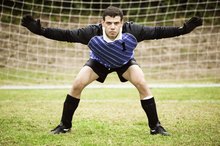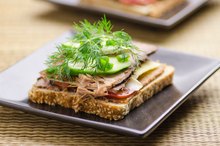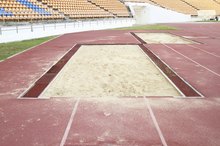The Diet for a Long Jumper
Long jumpers are an unique type of track athlete who require equal amounts of strength and endurance. Unlike some athletes, long jumpers strive to keep their figures lean and light-weight to help boost the distances of their jumps 1. While carbohydrate loading may be an effective way to store up energy for a competition, long jumpers should opt for a well-rounded diet that includes ample amounts of protein, carbohydrates and fiber.
Definition
Long jumping is a traditional track and field sport that can be broken down into three parts: The approach, the jump and the landing. Of these five, diet may play a significant role your ability to maintain endurance and develop strength. Protein is a key nutrient for growing and maintaining muscle tissue as you strengthen your legs, back and core muscles for jumping. Comparatively, carbohydrates can help provide the blood sugar to fuel the bursts of energy you’ll need for running and jumping 1.
- Long jumping is a traditional track and field sport that can be broken down into three parts: The approach, the jump and the landing.
- Protein is a key nutrient for growing and maintaining muscle tissue as you strengthen your legs, back and core muscles for jumping.
Long Jumper Diet Basics
Diets for Running Backs in the NFL
Learn More
The basic nutritional component of a long jumper diet is calories. By consuming calorie-rich foods such as whole grains and lean proteins, your body metabolizes enough energy to meet the demands of long jumping. However, maintaining a lean physique requires a balance between the number of calories you consume and the number of calories you burn off with physical activities. If you find yourself gaining weight over time, lay off the amount of sodas, candy bars, snack foods and other empty calories that offer more calories than nutrients.
- The basic nutritional component of a long jumper diet is calories.
- By consuming calorie-rich foods such as whole grains and lean proteins, your body metabolizes enough energy to meet the demands of long jumping.
Choosing Meals
The McCain Track and Field website recommends adopting regular meals to help maintain a steady flow of energy throughout the day. Begin with a breakfast made of low-sugar cereals, toast or chopped fruit, and focus on carbohydrate-rich foods such as:
- bread
- pasta
- rice
- noodles
- potatoes for midday meals
These carbohydrates provide glucose to your muscles and tissues while storing up glycogen deposits for long-term energy and endurance.
Safety Concerns
Goalkeeper Diets
Learn More
Talk to your doctor or dietitian before making any drastic changes to your diet. Your body requires a sufficient amount of nutrients and calories to keep your body functioning properly, and some diets may result in starvation or malnutrition. Along with nutrition, proper hydration is required to maintain electrolyte levels. When in doubt, ask a qualified sports nutritionist about the ideal diet for your body composition and energy needs.
- Talk to your doctor or dietitian before making any drastic changes to your diet.
- Your body requires a sufficient amount of nutrients and calories to keep your body functioning properly, and some diets may result in starvation or malnutrition.
Related Articles
References
Writer Bio
Based in the Appalachian Mountains, Brian Connolly is a certified nutritionist and has been writing professionally since 2000. He is a licensed yoga and martial arts instructor whose work regularly appears in “Metabolism,” “Verve” and publications throughout the East Coast. Connolly holds advanced degrees from the University of North Carolina, Asheville and the University of Virginia.









